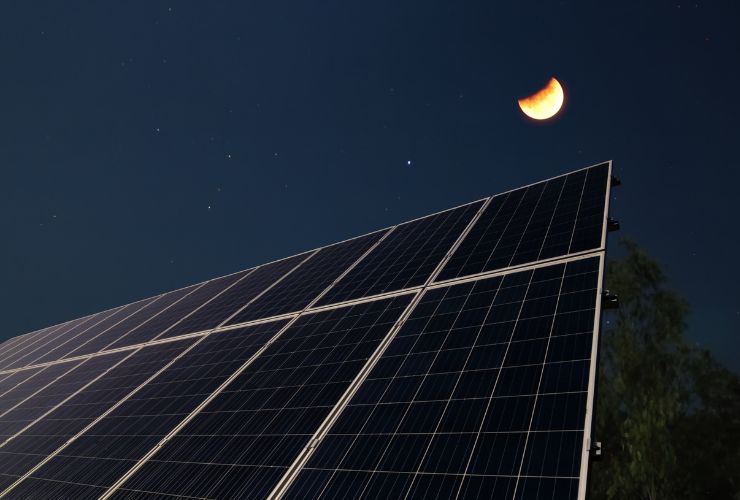
Fast read
The sun's light affects the solar system's energy production. More electricity is generated on sunny days, but less on cloudy or rainy days. This goes for solar at night; without direct sun rays, the panels cannot convert energy into electricity.
Solar systems generate the most electricity during midday when the sun is at its highest point in the sky.
Solar systems won't generally create electricity at night, though specific solar inverters might use a tiny amount. Solar storage systems and net metering can help make solar systems sustainable at night. This is achieved by storing any excess electricity generated during the day and selling it back to the electrical grid.
Will my solar system produce electricity when there is little or no sun?
The sunlight on your panels will determine how much electricity comes out of them, so when it’s cloudy, no sun= no energy. A solar panel’s purpose is to capture this sunlight, also known as photovoltaic energy, and convert it to direct current power. The power from nature is changed to a different type of power that most homes use.
Your solar power system will begin functioning when the panel generates solar electricity. This typically occurs around 6:00 or 7:00 in the morning when the sun rises.
Overall, a solar system will produce quite a bit less in the early hours of the morning; then, in the middle of the day, when you have the brightest sunlight, it will usually produce the most. Then, in the afternoon, renewable energy production slowly comes down again. So you will see an inverted U-shaped curve in solar energy production.
Some of the inverter models will consume a little bit of electricity during the night, but it isn’t essential, so, in simple terms, your solar system will produce during the day but not at night.
We recommended programming pool pumps to run during the peak electricity production time of your solar system. This time is typically in the middle of the day.

How much electricity will solar generate in rainy or cloudy weather?
Many people worry about solar systems not producing electricity when it’s rainy or cloudy.
I have observed for over 10 years and have found a useful tip for these situations. The tip is to imagine having a 6-kilowatt system that functions effectively in normal sunlight at noon. This system produces 4 to 5 kilowatt hours at its highest point.
On rainy or cloudy days, the system’s power generation decreases a lot, usually to about one-third of its normal power output. During rainy or cloudy periods, your 6-kilowatt system will generate less energy. In good sunlight, it usually produces 5 kilowatts. However, during these periods, it will only generate around 1.6-kilowatt hours.
Even though your solar system may produce less energy in bad weather, it will still help lower your electricity bills. Even though less is produced, the energy made can lower your dependence on grid electricity and save you money.
Understanding these fluctuations in solar generation during different weather conditions is crucial for realistic expectations. Rainy or cloudy weather may affect solar productivity, but your system’s ability to still generate electricity is valuable for saving energy.
Solar production may decrease in bad weather. However, the overall benefits and savings from your solar PV system still continue, although at a lower rate. This helps you reduce your electricity costs.
What will solar production look like on a sunny day?
If you have a sunny day, you probably start with 1.5-kilowatt-hour production in the morning, and by midday, you’re sitting at 5 to 6-kilowatt hours production, and then it goes down again to 3 and 2 and 1 kW/h towards the late afternoon.
But if you have a rainy day, you might only start with 500 watts in the morning, and then during the day, you’re only producing 1.5 – 2 and then even less in the afternoon. So if your panels are not functioning at the level that they should, this may be associated with several reasons.
On a day with clouds and sun, you can sometimes produce 5 kilowatt hours. But after 2 minutes, production drops to 2 kW/h. After 5 minutes, when the clouds are gone, you go back to producing 4 or 5 kW/hs.
Solar energy production experiences fluctuation both up and down. But solar is generally worth it because you’re taking the edge off your electricity bill even on a rainy day. After all, the system will chill and still generate, what I call, acceptable levels of electricity.
When a system makes more electricity than needed, it is sold to your energy company and you get paid for it.
What about solar production at night?
Solar panels can now store electricity and work at night, thanks to advancements in solar storage and net metering. This has greatly improved the clean energy of solar systems beyond daylight hours.
Net metering stands out as a cornerstone contributing to the attractiveness of home solar panel systems. Here’s how it works: when your solar panels produce more electricity than your home consumes, the surplus power is sent back into the grid. In turn, the power company provides you with credits on your electric bill. These credits effectively compensate you for the excess energy you supply to the grid.
Net metering helps reduce your electricity expenses by compensating for the lack of solar panel activity at night. During the day, any excess electricity you generate can be used as credits. These credits can then be applied towards the electricity you consume from the grid at night.
Basically, it’s a way to balance out the costs of electricity. When your solar panels produce more energy than you need, it can cover the times when they don’t generate power.
This process turns your solar investment into a more financially viable and sustainable option. It promotes green energy and helps homeowners save money by using the extra energy they’ve contributed to the grid.
Solar storage and net metering help homeowners use solar energy at night and maximise the financial benefits of their solar systems. These two technologies work together to address the challenge of using solar power when the sun is not shining.
Solar storage allows homeowners to store excess energy generated during the day and use it at night. Net metering allows homeowners to sell any excess energy back to the grid, effectively offsetting their electricity costs. By using both solutions, homeowners can use their solar systems more and rely less on traditional energy sources.
Another solution is a home solar-plus-storage battery combination. This system allows your home to access electricity overnight when solar panel production is inactive.